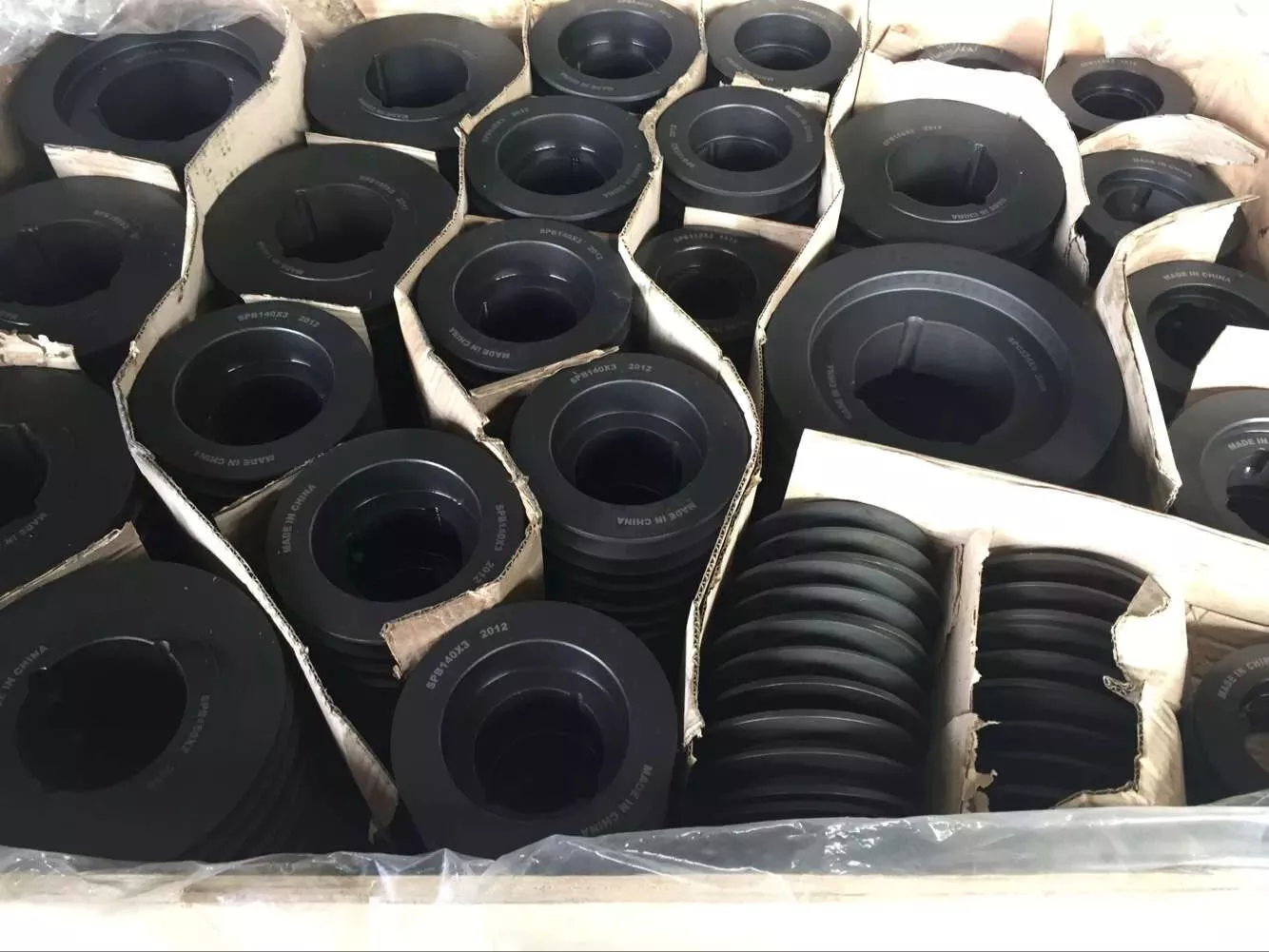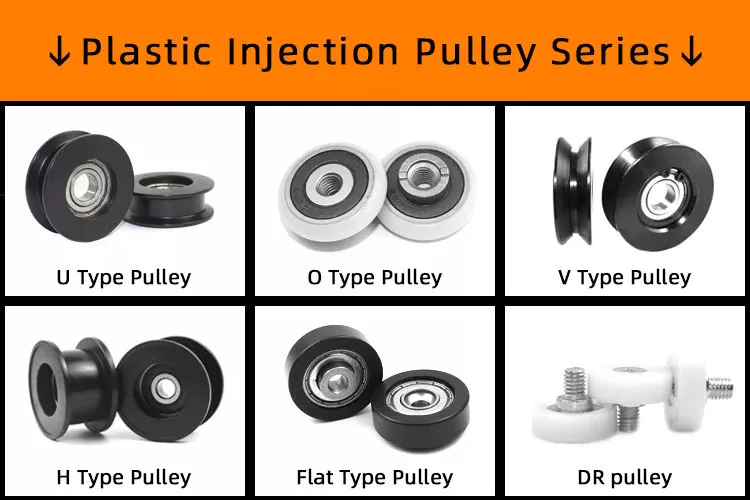Opis produktu
material: carbon steel, plastic, bearing steel, SS etc.
production craft: machining, milling, assembling, mold injection etc.
batch quantity: communications
delivery: 20-35days according to actual production craft
package: paper box, then pallet
As an experienced manufacturer, We`ve been engaged in OEM production since 2006, and we now own a 13000m2 working area. Our production capacity is up to diameter 400mm & length 1000mm (small are middle ones are OK too), and our management system is ISO9001:2015.
We can print batch mark on surface for quality tracking if need. Production records can be reviewed for up to 5 years
Quality warranty: as drawings. If not, we will return the payment of weak part, or make new lot to replace them with free.
Payment: in order to reduce your quality risk and funds pressure, 20% deposit and balance in 30days after BOL date are negotiable.
Delivery: about 25days regularly. It`s affected by quantity, technology need etc. details.
package: small parts: 10pcs*N per plastic bag, then to wooden case
big parts: unit, then to wooden case
wooden material: clad plate without any original wooden material.
“Hengyu Machining” as factory mark on wooden case for tracking work.
Our quality & service have been proved by several famous groups in these years including Chinese CHR, Bombardier, etc. E-catalogues will be sent if needed.
5W:
Whom we are
We`re specialized CNC precision machining manufacturer, with abundant experience. Our business covers some continents market and places. We have bright advantage in quality as need.
What we can do?
We supply metallic production & design service to OEM, ODM and end-user wholly, promptly and correctly.
Who is our client
Our clients include OEMs and end-user companies whose products go through complex and hi-volume production and manufacturing processes prior to CHINAMFG the consumers. For these companies, we`re remarkable and reliant co-worker. Our clients include train manufacturer, watercraft manufacturer, food(drinking) equipment manufacturer, analyzer manufacturer, medical instruments manufacturer, construction equipment manufacturer etc.
What you could expect
professional, prompt and correct communication
eligible, longevous and precision products
credit and prompt delivery
Why should you choose us?
We promises to offer excellent service, quality and delivery to build business credit – create mutual credit, long-time business relations.
Any interest, please feel free to contact us. we`ll reply you in 24 hours. thanks!
| Customize Bearing: | Customize Pulley |
|---|---|
| Pulley: | Łożysko |
| Roller: | Shaft |
| Próbki: |
US$ 100/Piece
1 sztuka (minimalne zamówienie) | Zamów próbkę as drawing
|
|---|
| Personalizacja: |
Dostępny
| Spersonalizowane żądanie |
|---|
.shipping-cost-tm .tm-status-off{tło: brak;wypełnienie:0;kolor: #1470cc}
|
Koszt wysyłki:
Szacowany koszt przesyłki za jednostkę. |
o kosztach wysyłki i szacowanym czasie dostawy. |
|---|
| Metoda płatności: |
|
|---|---|
|
Płatność początkowa Pełna płatność |
| Waluta: | US$ |
|---|
| Zwroty i zwroty pieniędzy: | O zwrot pieniędzy możesz ubiegać się w ciągu 30 dni od otrzymania produktów. |
|---|

Jak działają koła pasowe w różnych typach pojazdów i maszyn?
Koła pasowe odgrywają kluczową rolę w wielu typach pojazdów i maszyn, umożliwiając przenoszenie mocy, sterowanie systemami mechanicznymi i wydajną pracę. Oto, jak koła pasowe działają w różnych zastosowaniach:
1. Silniki samochodowe: W pojazdach koła pasowe są powszechnie stosowane w układzie napędu osprzętu silnika. Koło pasowe wału korbowego, znane również jako tłumik drgań skrętnych, jest połączone z wałem korbowym silnika i napędza różne akcesoria, takie jak alternator, pompa wspomagania układu kierowniczego i sprężarka klimatyzacji. Koła pasowe umożliwiają przenoszenie mocy obrotowej z silnika do tych akcesoriów, umożliwiając im wykonywanie ich odpowiednich funkcji.
2. Układy napędzane paskiem: Koła pasowe są szeroko stosowane w układach napędzanych paskiem w różnych maszynach i urządzeniach. Te układy wykorzystują paski, takie jak paski klinowe lub paski rozrządu, które owijają się wokół kół pasowych w celu przenoszenia mocy. Przykłady obejmują systemy przenośników, maszyny przemysłowe, sprzęt rolniczy i systemy HVAC. Koła pasowe zapewniają niezbędny chwyt i napięcie, aby zapewnić wydajne przenoszenie mocy i działanie układu napędowego.
3. Dźwigi i wciągniki: Krążki są integralnymi elementami dźwigów i wciągników, umożliwiającymi podnoszenie i przemieszczanie ciężkich ładunków. Wiele krążków, często ułożonych w konfiguracji bloków i wielokrążków, jest używanych do tworzenia przewagi mechanicznej, zmniejszając wysiłek wymagany do podniesienia ładunku. Poprzez rozłożenie ciężaru ładunku na wiele pasm liny lub kabla, krążki umożliwiają kontrolowane podnoszenie i precyzyjne pozycjonowanie obiektów.
4. Sprzęt budowlany: Krążki są stosowane w różnych typach maszyn budowlanych. Na przykład w koparkach i dźwigach krążki są używane w systemach lin stalowych do podnoszenia i opuszczania wysięgnika, łyżki lub innych elementów osprzętu. Krążki pomagają w zarządzaniu siłami zaangażowanymi w te operacje, zapewniając płynny i kontrolowany ruch.
5. Windy: Krążki są niezbędnymi elementami systemów wind. Kabiny wind są zawieszone na stalowych linach, które biegną nad krążkami. Krążki te są połączone z silnikiem elektrycznym za pomocą układu przekładni i kół pasowych. Gdy silnik obraca krążki, kabina windy porusza się w górę lub w dół. Krążki w systemach wind pomagają w wydajnym przenoszeniu mocy i utrzymaniu stabilności i bezpieczeństwa transportu pionowego.
6. Sprzęt do ćwiczeń: Krążki są szeroko stosowane w maszynach do ćwiczeń i sprzęcie do ćwiczeń, aby zapewnić opór i umożliwić regulację poziomów oporu. Dzięki zastosowaniu systemów krążków o różnych konfiguracjach i układach kabli sprzęt do ćwiczeń może oferować różnorodne ćwiczenia ukierunkowane na określone grupy mięśni.
7. Zastosowania morskie: Krążki są wykorzystywane w różnych zastosowaniach morskich, takich jak żaglówki i wyciągarki. Krążki pomagają kontrolować ruch i napięcie lin i kabli, umożliwiając regulację żagli, podnoszenie i opuszczanie masztu oraz inne operacje takielunkowe.
8. Drzwi garażowe: W mechanizmach drzwi garażowych stosuje się koła pasowe, aby ułatwić płynne otwieranie i zamykanie drzwi. Stosuje się je w połączeniu z linkami lub pasami, umożliwiając przeniesienie siły z otwieracza drzwi na same drzwi.
Te przykłady pokazują wszechstronność i znaczenie kół pasowych w szerokiej gamie pojazdów i maszyn. Wykorzystując koła pasowe, systemy te mogą osiągnąć wydajną transmisję mocy, przewagę mechaniczną, kontrolowany ruch i ulepszoną funkcjonalność.

How do pulleys contribute to the functioning of bicycles and motorcycles?
Pulleys play important roles in the functioning of both bicycles and motorcycles, aiding in power transmission, speed control, and overall mechanical efficiency. Here's how pulleys contribute to the operation of these vehicles:
1. Bicycles:
– Derailleur System: In most modern bicycles, pulleys are used in the derailleur system. The derailleur is responsible for shifting the bicycle chain between different gears on the front and rear sprockets. Pulleys, often referred to as jockey wheels, are positioned in the derailleur to guide and tension the chain as it moves between gears. They ensure smooth and precise shifting, allowing the rider to adapt to various terrains and maintain an optimal pedaling cadence.
– Belt Drive Systems: Some bicycles use a belt drive instead of a traditional chain drive. Belt drives employ a pulley system that consists of a front pulley attached to the pedal crank and a rear pulley attached to the rear wheel hub. The belt is wrapped around these pulleys, transferring power from the rider's pedaling motion to propel the bicycle forward. Pulleys in belt drive systems enable efficient power transfer, reduce maintenance needs, and provide a quieter and cleaner alternative to chain drives.
2. Motorcycles:
– Clutch System: Pulleys, known as clutch pulleys, are utilized in motorcycle clutch systems. The clutch connects the engine to the transmission and allows the rider to engage or disengage power transmission to the rear wheel. When the clutch lever is pulled, the clutch pulley separates the engine's rotational motion from the transmission, disengaging power transfer. Releasing the clutch lever brings the pulley back into contact, engaging power transmission and enabling the motorcycle to move.
– Variable Transmission Systems: Some motorcycles employ pulleys in variable transmission systems, such as continuously variable transmissions (CVT). CVTs use a pair of pulleys connected by a belt or chain. By changing the diameter of the pulleys, the CVT adjusts the gear ratio continuously, providing seamless and efficient power delivery across a wide range of speeds. Pulleys in variable transmission systems contribute to smooth acceleration, improved fuel efficiency, and enhanced riding comfort.
– Drive Belt Systems: Pulleys are also utilized in motorcycles equipped with belt drive systems. Similar to bicycles, these systems consist of a front pulley connected to the engine's crankshaft and a rear pulley connected to the rear wheel. The belt runs around these pulleys, transferring power from the engine to the rear wheel. Belt drive systems offer advantages such as reduced maintenance, quieter operation, and smoother power delivery compared to traditional chain drives.
Overall, pulleys are integral components in bicycles and motorcycles, contributing to smooth gear shifting, efficient power transmission, and improved overall performance. Whether in derailleur systems, belt drive systems, clutch systems, or variable transmission systems, pulleys play a vital role in enhancing the functionality and ride experience of these vehicles.

What are the advantages of using pulleys for mechanical advantage?
Using pulleys for mechanical advantage offers several advantages in various applications. Here are the key advantages:
1. Increased Lifting Capacity: One of the primary advantages of using pulleys for mechanical advantage is that they allow for the lifting of heavier loads with less effort. By distributing the load over multiple segments of rope or belt, pulleys reduce the amount of force required to lift the load. This is especially beneficial in scenarios where manual lifting or limited power is involved.
2. Easier Load Manipulation: Pulleys make it easier to manipulate and control heavy loads. The mechanical advantage provided by pulleys reduces the force needed to move or lift the load, allowing operators to exert less effort. This makes tasks such as lifting, lowering, and positioning heavy objects more manageable and less physically demanding.
3. Safety and Injury Prevention: By reducing the amount of force required to lift heavy loads, pulleys contribute to improved safety and injury prevention. When operators have to exert less physical effort, the risk of strains, sprains, and other lifting-related injuries is significantly reduced. Pulleys enable controlled and smoother load movement, minimizing the risk of sudden shifts or drops that could cause accidents.
4. Precise Load Positioning: Pulley systems provide precise control over load positioning. By using multiple pulleys and adjusting the tension in the rope or belt, operators can achieve precise vertical and horizontal movements of the load. This level of control is particularly valuable in applications that require accurate placement of heavy objects, such as construction, manufacturing, and material handling.
5. Versatility and Adaptability: Pulleys offer versatility and adaptability in various applications. They can be configured in different arrangements and combinations to achieve specific mechanical advantages based on the requirements of the task or load. Pulleys can be easily integrated into existing systems or incorporated into custom-designed setups, making them highly adaptable to different situations.
6. Efficient Power Transmission: Pulleys provide efficient power transmission in mechanical systems. They enable the transfer of rotational motion and force from one component to another with minimal energy loss. The use of pulleys allows for the optimization of power transmission, ensuring effective utilization of available power sources.
7. Cost-Effectiveness: Using pulleys for mechanical advantage can be cost-effective compared to alternative methods. Pulleys are relatively simple and economical devices that can be readily obtained. They require minimal maintenance and have a long operational lifespan. Additionally, pulley systems can often be designed and implemented without the need for complex and expensive equipment.
In conclusion, using pulleys for mechanical advantage offers advantages such as increased lifting capacity, easier load manipulation, safety and injury prevention, precise load positioning, versatility, efficient power transmission, and cost-effectiveness. These advantages make pulleys a valuable tool in a wide range of industries and applications.


redaktor przez CX
2023-12-11
